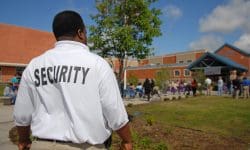4 Reasons Campuses Should Use Outsourced Contact Tracing Amidst Rising COVID-19 Threats
Reduced costs and reduced burdens to facilities and security teams are just some of the reasons colleges should consider hiring a managed service provider to run their contact tracing program.

As we come to terms with the impacts of COVID-19, we are receiving more guidance from the Centers for Disease Control, as well as individual state governments, on managing the processes associated with reopening schools. Primary among those recommendations is the use of exposure tracing (contact tracing) to ensure that any outbreaks are swiftly managed and further spread of the virus is prevented.
As we’ve seen over the last few months, public-run contact tracing processes can be woefully inadequate. That’s why many higher education facilities are taking it upon themselves to implement exposure tracing protocols internally to keep students, staff and faculty safe. But managing a complex program like this requires a blend of technology and human interactions, often in delicate scenarios and time-sensitive situations.
Given that an entire education facility is actively trying to adjust to all of the changes simultaneously, there are a number of reasons to outsource the program to a managed service provider (MSP) in an effort to address the challenges that education facilities face. Here are just a few of them:
1. Reduced Burden on Facilities Managers and Security Teams
Your facilities management and physical security, legal and technology teams – not to mention the faculty and staff tasked with interacting with students daily – are likely to be under a great deal of pressure in the current environment. Physical security teams, in conjunction with facilities management, are finding themselves responsible for policing and enforcing health and safety changes being put in place. Currently, they are best deployed in visible roles, helping the people they see every day adjust to this new way of life. Similarly, facilities managers and school liaisons are managing a number of incidents, from return-to-school issues/policies to limited resources, and in some cases, dealing with sanitizing protocols and procedures in an effort to meet stringent state and federal guidelines for reopening all while dealing with a broken supply chain.
Outsourcing exposure tracing to an MSP not only alleviates additional burden on these teams but allows them to focus on the jobs they were set to do without another role to play in the already stressful return-to-school planning.
2. Proven Exposure Tracing Processes
Mike Tyson famously said, “Everyone has a plan until they get punched in the face,” and that can be easily applied to processes and procedures within an educational environment. They may look fantastic on paper and work perfectly in simulations, but as soon as a real-life incident takes over, holes can be quickly exposed, and these organizations can find themselves inadequately prepared for the real-life challenges that COVID-19 presents from a process, workflow and protection standpoint. Given how new the COVID-19 pandemic is, and its uniqueness, creating and implementing a robust exposure tracing program is complex and time-consuming for a problem we all hope is temporary.
MSPs have operated through emergency, real-life incidents on a regular basis and have a wealth of experience to draw upon. It is likely that they’ve seen and experienced all of the unusual situations that can occur and mitigate risks, close accidental risk exposure and implement the service more efficiently for education leaders.
3. Reduced Technology Costs and Training
Technology has a cost; and as we all hope that the pandemic will fade away and life will truly return to normal, investing in new technologies may not be the most effective use of school budgets currently. Should you invest in contact tracing technology, there is still a long timeline to have the technology delivered, installed and to train employees on the processes and use of that technology. This is all after you’ve spent the time making sure that the technology you’ve invested in is the correct technology in the first place.
MSPs have already been through these processes with technology vendors and often have agreements and special licenses in place with those vendors to quickly and easily incorporate that technology into a school’s security plan. They’re already trained on the solution, and the processes and operations behind them. This can save valuable time and money versus implementing the technology yourself. The final benefit is that when operations return to near-normal levels, operations departments can re-evaluate the use of the service and adjust accordingly.
4. Mass Communications
When dealing with a higher education facility during the identification of an infection or outbreak, it’s likely you as a security leader will have a load of work to get through. Most importantly, you have to identify and get in touch with a large number of people in a short span of time, disseminate important information and manage any ongoing cases and critical information.
The most effective way to do this is through a mass communications technology platform. In the situation where someone finds out that they are COVID-positive (or presumed positive), it is unlikely they will remember everyone that they have been in contact with. You also have the issue of identifying all of the people who are truly contacts based on both the clinical definition and school policy. Impacted personnel or students could also likely include members of the security, facilities and student advocate teams. A remote MSP remains isolated and can implement exposure tracing procedures including rapid notifications, credential deactivations and other critical functions.
Students and parents have a lot of worry and hesitation about being back in a school environment in the first place, so the last thing they want to spend time worrying about are the day-to-day management of an outbreak. Demonstrating that processes are in place to address these concerns, limit more exposure and protect the broader student population is important to all stakeholders as classes resume and we adjust to a “new normal” in the learning environment.
Ryan Schonfeld is founder and CEO, RAS Watch. The views expressed by guest bloggers and contributors are those of the authors and do not necessarily represent the views of, and should not be attributed to, Campus Safety magazine.
If you appreciated this article and want to receive more valuable industry content like this, click here to sign up for our FREE digital newsletters!
 Leading in Turbulent Times: Effective Campus Public Safety Leadership for the 21st Century
Leading in Turbulent Times: Effective Campus Public Safety Leadership for the 21st Century
This new webcast will discuss how campus public safety leaders can effectively incorporate Clery Act, Title IX, customer service, “helicopter” parents, emergency notification, town-gown relationships, brand management, Greek Life, student recruitment, faculty, and more into their roles and develop the necessary skills to successfully lead their departments. Register today to attend this free webcast!













